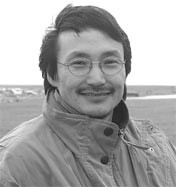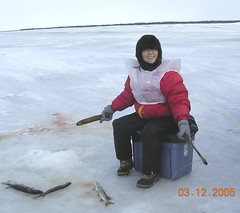Alaska Journal of Commerce -- WealthBuilder Column
Tim Pearson, June 13, 2004

Abe David
The Wealthiest Man in Alaska
by Tim Pearson
The wealthiest man in Alaska lives on Nunivak Island. His name is Abe David and he possesses the ability to turn straw into gold. Actually, he can make it even more valuable than gold.
Abe is a hunting and fishing guide extraordinaire. I met him this past week on the way out to the Nash Harbor science and technology camp on Nunivak. He told the following story:
One summer he had two clients from the Lower 48 – he thought they were friends – and took them out fishing. They were having mixed success, so with ever present good humor, he figured he’d show them how to do it. Abe being Abe, he hooked a big Dolly Varden on his first cast.
In the excitement of landingthe fish, he slipped off the rock he was on and fell into the icy water. The fish got away and he got drenched. His clients had a good laugh, but they laughed even harder when he stuffed his pants and shirt full of dried beach grass. No matter. The day wore on, he became warm and his clothes even dried out.

Later in the day he left the men in camp and when he came back he saw only one of the partners. He discovered that they had had a falling out and the other man had walked out of camp. They went looking for him but couldn’t find him. In fact, they really couldn’t find him – not a trace. After doing their best, they returned to Mekoryuk for a larger search party. Abe had a sleepless night knowing his client was out in the cold alone on the tundra.
The next morning as Abe looked out his window preparing to search again, he saw his client walking into town. The client had left camp, taken a nap on the tundra, became disoriented when he awoke and started walking along the river – away from town. Night fell and when he saw the lights of Mekoryuk behind him, he turned around and walked back in.

Then the client sprawled out on Abe’s front porch and told Abe, “It works.” He opened his pants and shirt to show that they were stuffed full of dried grass. He was scratchy, but warm. Like the hollow hairs of reindeer and caribou fur, the hollow stems of the dried grass served as the traditional natural insulator against hypothermia. The grass went home with him as a souvenir of his Alaskan adventure.
You pick up wisdom from hanging around Abe. It is who he is. He’s passionate about making a difference. He’s the field coordinator for the Nash Harbor sea kayaking camp, an educational, cultural, and adventure subsidiary of Nunivak’s village corporation, NIMA. Ten high school students from the YK Delta will be using it for a June science program. Other adventure and cultural activities will also occur through the summer. It’s part of a long-term, sustainable economic initiative for an island community of 215 in the Bering Sea.

However, for Abe, it’s about something much, much larger. It’s about being an entrepreneur. Abe’s favorite phrase: “It’s a saleable project.” It’s about being in charge of one’s own economic destiny. Abe’s favorite comment: “We’ll show you how it’s done. Just give us a chance.” It’s about passing on life lessons. Abe’s favorite summary on seizing life by the horns: “I wish I had started earlier. I could have done so much more.”
In the entry way to the NIMA Grocery store on Mekoryuk, there is a xeroxcopy of an old photo from the 1950’s or 1960’s of ten small kids standing in a group. They’re all of five to seven years old and are dressed in parkas, mukluks and mittens. Hand-typed captions identify the kids’ professions: council member, VPSO (village public safety officer), heavy equipment operator, carver (two) and preacher.

Abe stands in the back row: pilot. Kids turn into the future. Straw turns into warm survival. Wisdom turns into economic ventures and wealth. Abe is a wealthy man. Lest you doubt me, he’s the one who has a millennia-old summer fish camp between Nash Harbor and Mekoryuk. Value: priceless.
So then, what straw do you have at hand?
Tim Pearson is a Professional/Business Coach who helps people design meaningful careers and build great companies. He is at www.timpearson.net and can be reached at: (907) 562-1568 or by e-mail at tim@(remove this) timpearson.net.






















